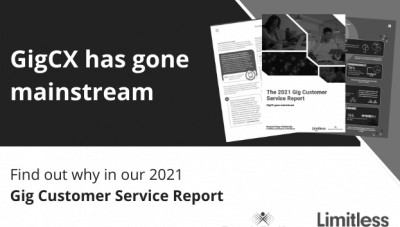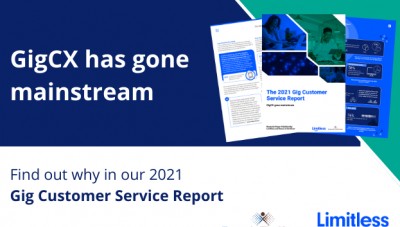How to become GigCX ready
Article |

A guest blog from Paul Weald - the Contact Centre Innovator - previously published on LinkedIn.
As the future world of work changes, the importance of the gig economy will expand from car ride sharing and home sharing into skills sharing between customers and organisations. This will change the dynamics of how customer service is delivered - creating the ability for customers to help their peers to resolve service issues - alongside the traditional service delivered by contact centres and automation through AI. Our latest webinar tells you all you need to know.
The characteristics of the gig economy
The gig economy gets its name from each piece of work being akin to an individual 'gig'. There are three key attributes that are relevant to gig workers:
- they are independent in choosing work tasks
- they work from home or remotely from the organisation (typically receiving requests via a technology platform or app)
- and they provide their services "on demand"
These characteristics have led to the gig economy being thought of as a "sharing economy" where users share their cars to give lifts to others e.g. Uber, users share their homes e.g. AirBnB, and users share their skills by providing freelance services on platforms such as Fiverr.
This concept of sharing is useful when considering the role of gig workers to undertake customer service tasks. Knowledgeable customers - who use an organisation's products or services day-in and day-out - have a unique insight into how to solve what may seem like routine or general enquiries that other customers face. And given that customers can rate each and every gig worker experience, this ensures that only the very best people are helping other customers.
Based on these attributes of the sharing economy, when trust is high, customer satisfaction in delivery of the service will go up. This means that you should expect customer service tasks that are resolved by customers to command a higher CSAT rating in terms of feedback than your contact centre agents can achieve in providing responses to those enquiries - typically an uplift of 5-10%.
A second factor where the gig economy can help an organisation is around availability of staff. In a well run contact centre, the utilisation of agents is high as the operational planning teams will be doing a good job of aligning the supply of agent resources to expected demand. But the downside of this approach is that there is little wriggle room when the unexpected occurs, and customer contact demand increases significantly. There is no spare internal capacity in terms of agent resources that can be flexed up instantly in response.
But think for a moment about the working pattern of gig workers. They are available on-demand and typically choose to do work when they have the time and they know that there are opportunities available. So when the contact centre is struggling with excessive demand then pushing more work out to a pool of existing customer gig workers is a ready-made solution to that operational problem, with the gig resource pool typically being able to handle a surge in demand of up to 10 times greater than forecast.
The third factor in favour of using gig workers to resolve service enquiries is that the cost-to-serve financial ratio can be lower, with savings up to 50% possible compared to paying contact centre agents premium overtime rates to handle incremental demand. Whilst there are good practices that need to be followed in terms of the gig worker reward and compensation for the tasks that they complete - typically gig-workers can earn 30% more per task completed compared to internal basic staff time cost - the other factor to consider is that gig workers don't need office space, laptops or direct supervision. This in turn lowers the fully loaded cost to resolve the enquiry which makes it attractive when compared to internal resources plus facility overheads plus infrastructure costs. And it's good for the environment too!
Put this all together and then you have a compelling business case to divert some of your general enquiries to a pool of knowledgeable customers providing gig support - an outcome where customer ratings go up, cost to serve goes down and the ability to meet Service Level (particularly when the unexpected occurs) improves. A triple whammy!
If you want the proof from the early adopters of gig based customer service, then watch the following video to hear how US corporations such as Microsoft, Sun Basket and Postmates are using our GigCX solution to manage their customer based crowdsourced functions.
What type of customer service tasks can gig workers perform?
The most relevant types of contact that you can apply to customer gig workers are product, technical or trouble shooting enquiries that arrive in a digital form. That includes asynchronous chat and messaging requests plus information provided through website contact us forms and certain types of email using structured questions. Phone calls don't lend themselves to gig, but what you can do is deflect calls by offering an IVR option when a caller is queuing to send them a messaging link that in turn is offered out to gig workers as a digital task. Compared to waiting in an IVR queue, some brands have seen over 25% of callers for specific enquiry types switch to messaging gig workers using this feature.
The other guideline with customers helping customers is that you have a duty of care to avoid any situation when a customer discloses Personally Identifiable Information (PII) to a third party. It is important to let customers know they shouldn't share personal information in free text - only in secure forms. It is also possible to use content filters to further protect those who ignore the advice and to use secure links so that customers can provide PII data to complete the task but in a way that the gig worker cannot see or access that customer information.
Another technological development with the latest customer service gig technology solutions is the application of AI. This helps you to develop the right routing rules to the enquiries that are directed to gig workers by using the best answers provided by the gig workers to train AI algorithms. As these algorithms mature it also becomes feasible to present suggested answers directly to customers to reduce the cost to serve even further.
The outcome is that gig workers of the future will handle wider enquiry types such as payments and refunds, cancelations, upgrades, etc. at the same time as the built-in AI technology completing the simpler enquires through self-service automation.
Find out more
A leading exponent of gig workers in customer service are Microsoft. You can find out how they have become #GigCX ready using our platform by watching our most recent webinar. You will learn how they have used gig in customer service to innovate and future-proof their operations. Download it here.
At the end of the day, we all know that it is the "human touch" that counts in customer service interactions and this is the most powerful attribute that gig based advocate customers possess.





